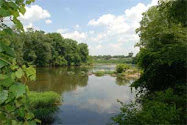 |
| Photo credit: Corie Smith |
Not
even the threat of downpours could dampen the excitement of a baby barn owl
viewing. Ready with boots, raincoats and umbrellas, chapter members Corie Smith
and Jenna Veazey ventured across the Potomac river to Maryland to support the
Southern Maryland Audubon Society’s (SMAS) banding of baby Barn Owls on May 5th.
Corie
and Jenna joined a group of other volunteers and supporters that met on private
property along the Wicomico River, which the group was instructed not to share
the exact location of…for the safety of the owls. Barn owls are rare breeders
in Maryland and are listed as In Need of Conservation.
Mike
Callahan, who also works as an interpreter at Caledon State Park in King
George, is a member of the SMAS. The group had been closely monitoring an owl
box on private property. Mike said there were only three known nests in Charles
County, Maryland.
Their
best guess was that this nest’s eggs had hatched the end of April. Barn owls
incubate their eggs as soon as they the first one is laid, opposed to ducks,
geese and songbirds which incubate after the last egg has been laid. And when the owlets have grown enough feathers
to maintain their body weight the parents don’t hang around the nest all day
anymore. There appeared to be five owlets, but as siblicide is not uncommon the
volunteers were cautiously optimistic we’d be able to tag all five on the banding
day.
 |
| Photo credit: Corie Smith |
Just
as the rain abated, Mike climbed the ladder up to the owl box. He urged everyone
to listen for the owlet’s hissing…which he said had been described as an
espresso machine. Very accurate, indeed! It didn’t take long after the
extraction of the first owlet for the hissing to turn into all-out shrieks. Five
owlets were carefully removed one-by-one and placed into individual cardboard
boxes for safe transport to the pavilion where they’d receive their ID bands. Mike
then called out for an extra box…there was a bonus sixth owlet that had been
hidden in previous observations!
Under
cover of a pavilion, USGS licensed bird bander, Ken Smith was in charge of banding
the owlets. He used size 7A aluminum bands specially gauged for barn owls, each
with their own unique identifying number. He explained the owlets’ legs were
already about as large as they'd get at this age and there was no worry that
the bands would grow too tight over time. As he worked, he also said that while
handling the owlets they had to be especially careful not to break any of their
flight feathers.
 |
| Photo credit: Corie Smith |
Mike
pointed out that barn owls have one toe with a pectinate comb, which they use
to groom the feathers on their facial discs.
Kerry
Wixted, Maryland DNR Wildlife Educator and Outreach specialist was also helping
out. She said that, “Barn owls are have been hit hard by habitat loss,
especially in Maryland. Grasslands with abundant voles and other rodents are
important for barn owls as well as open marshes.”
If
you would like to support local barn owl conservation in Maryland, consider
'adopting' an owl or other species through the SMAS program: https://www.somdaudubon.org/adopt-a-raptor/

















